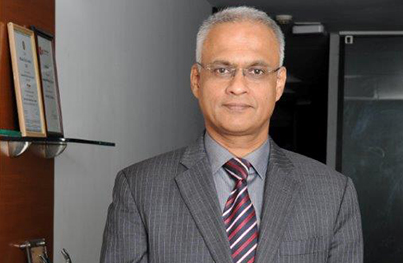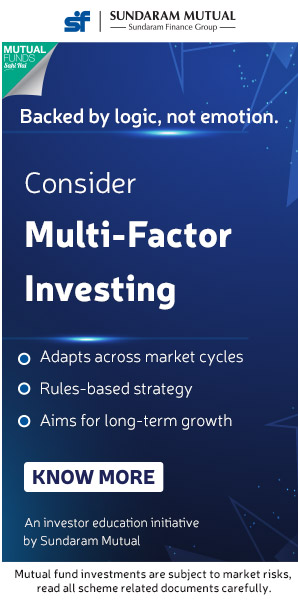Investors should pay less attention to the noise on long term average valuations
BFSI Industry Interview

Sunil Subramaniam - Chief Executive Officer
Sunil Subramaniam joined Sundaram Mutual in September 2005. During his tenure he has handled various roles – Vice President (Retail Distribution), Executive Director (Sales and Marketing), Director (Sales and Global Operations) before being elevated to his current role as CEO. Sunil is also on the Board of Sundaram Asset Management Singapore Pte. Ltd. Duringthe time he has been with Sundaram Mutual, the AUM of Sundaram Mutual has seen a manifoldgrowth.
Sunil has completed his Master in Business Administration from The Open UniversityBusiness School, London and is an MSc graduate from IIT, Madras. He is also a Certified Associateof the Indian Institute of Bankers.
He has over three decades of work experience in the financial services sector spanning across MNC, Public sector andPrivate sector companies. The companies he has worked with include State Bank of India,A merican Express Bank and Bank of America.
Can you highlight for our readers, some key accomplishments of Sundaram Mutual Fund in the recent past, especially with respect to the retail segment of your business?
Our average assets under management have grown from a level of Rs.24,500 crore in April to almost Rs.29,000 crore in August. This has come on the back of a strong growth of 130% rise in the number of customers starting fresh SIPs with us, accompanied by a 173% rise in value terms. We have also added 5% of our customer base in terms of new customer folios. Furthermore, this has been possible due to an addition of more than 600 IFAs to our active distributor base since April 2016.
The share of domestic mutual funds in market cap of Indian companies is highest ever now. Do you see this as a sign of growing maturity of Indian retail investors and do think that this trend is here to stay?
Yes, this has been driven largely by the rising proportion of SIPS in mutual fund inflows, which has helped mutual funds to remain consistent buyers of stocks even when FIIs have been selling due to global newsflows and/or liquidity changes. Given that most SIPs are contracted for 3 years or more, we expect this trend to continue for the next few years.
While the potential of B15 cities is well known, they lagged behind the top cities for a long period of time. However, recent AMFI data shows encouraging AUM growth from B15 cities. What is the experience of Sundaram Mutual Funds in B15 cities over the past one or two years?
The B15 penetration has been very encouraging even for us and today, almost 40% of our SIP flows come from this space and is driven by the fact that more than a third of our distributor base is from B15 areas.
We feel that the biggest hindrance for mutual fund growth has been the active number of Distributors. Their total size is miniscule compared to Insurance industry. Do not you think that industry should add more and more distributors in its fold and thus enhance the reach?
Yes, we agree with this and it is only through the increase in the number of IFAs that a proper expansion of the industry can happen. This is especially true since IFAs build long-term relationship with the investors and can properly explain the risks involved in equity investment and the potential of the same to create long-term wealth. However, comparison with the insurance industry are odious as the compensation structures are widely different.
Do you think Robo Advisory and the disruption that is happening in the financial services industry – Examples - E-KYC, linking Aadhar number to Mutual Funds, AMFI & Stock exchange platforms and Mobile Apps – will help grow the mutual fund penetration further or they will just take away/ participate in the existing pie of the fund industry?
All the examples mentioned are essentially robo execution which improve the ease of doing business and will definitely help grow the mutual fund penetration, given the high degree of comfort of the younger investing population to technology and the internet. Further, they will reduce transaction costs for the industry.
The use of technology over the last few years, have made mutual investments a much better experience for investors. Many distributors have adopted technology to improve transaction processing efficiency, but there are still large numbers of distributors who are not using technology as much as they should. Do you have initiatives planned or being planned to increase technology adoption by distributors?
Our efforts on the technology front are on enabling our sales force to service distributors better using digital tools. Necessary facilitation/enablers are also being done through our website to facilitate distributor oriented transactions.
The concerns among sections of mutual fund distributors that, with implementation of the GST Bill, the cost of mutual funds will go up by 3% or even more (difference between the current service tax rate and the GST rate). What is you view with regards to, who will bear this extra tax burden, the investor, the distributor or the AMC?
The current model that is prevalent will continue to operate.
For the benefit of our readers, can you please give us your outlook on the stressed assets problem in the public sector banks? What would be the role of The Bank Board Bureau (BBB) announced by the NDA government to improve governance at public sector banks?
We believe that the stressed assets problem was more of one of disclosure of what were hitherto classified under restructured assets. The overall pool of stressed assets plus declared NPAs has seen only a smaller rise and we believe that with economic growth remaining buoyant, the situation will only improve in the coming years. The Bank Board Bureauwould ensure that the quality of the personnel and overall supervision in the public sector banks will significantly improve.
There have been much fewer NFOs so far this year compared to 2014 and 2015. We understand that, SEBI is going slow on approvals. What is the thought process of Sundaram Mutual Fund on equity NFOs in 2016 and beyond?
SEBI has been going slow on open-ended fund approvals based on their stated intention to rationalise existing schemes and encourage merger of similar/underperforming funds. In the past, we have launched close-ended NFOs when we have felt that these represented opportunities for wealth creation for investors based on valuations and earnings growth potential. We do have quite a few close-ended NFO approvals on hand. We will evaluate and launch in the coming months based on the criteria.
Coming to the Indian stock market, we have seen a fantastic rally over the past 5 or 6 months. Though we always stress in Advisorkhoj that, investors need to have a long time horizon for equity investments, there are concerns among some of our readers, if the market is overvalued right now? What is your view? What is your 2 – 3 year outlook for Indian equities?
In our view, concerns on overvaluation of the market are a bit overdone. Given the growth potential of the Indian economy, the low growth and negative interest rate scenario prevalent in advanced economies, the continuance of strong liquidity from domestic investors and FIIs, we believe that the equity markets will deliver FD beating returns over the next 3 to 5 years.
The small and midcap equity mutual funds have outperformed the large cap oriented funds in the last two years or so. What is your advice to investors with regards to market cap strategy in particular and approach to mutual fund investments in general?
The small and midcap equity mutual funds have outperformed the large cap oriented funds in the last two years or so. This has been on the back of an improvement in their valuation from the depressed levels prevailing 3 years ago. We believe that small and midcap will continue to outperform the large cap in the next 3 to 5 years based now on the higher earnings growth potential. A study of past economic cycles and market caps will reveal that whenever economic growth is strong and rising, small caps and midcaps tend to outperform large caps in terms of returns. Some of the main reasons for these are the high operating and financial leverages of small and midcap companies that helps them deliver much more that proportionate rises in profit to sales ratios in a good economic environment. Thus, investors in their approach to mutual fund investments must have a balanced allocation across the cap curve fine-tuned by the current status of the economic growth cycle and the age and risk bearing appetite of each investor.
We find that the top 5 sectors for almost all the AMCS are now Banking and Financial, Construction, Technology, Services and automobiles. Does your fund management team following the same sector allocation trends for your funds? If no, then what other sectors you are bullish on? If yes, do you still think more is expected from these sectors?
Our fund management team has a greater bottom-up approach backed by a strong research team. What this means is that emphasis is laid on picking good quality stocks with scalable, sustainable business models and using a Growth At Reasonable Prices(GARP) approach to stick picking. Hence, our sector allocations are generally a resultant of this approach while we do keep an eye on sectoral exposure vis-a-vis fund benchmarks to enable us to provide better returns. That being said, given the current environment, we believe that consumption with a rural tilt and the broader financial services space provide good wealth creation opportunities.
Anything else would you like to add Mr. Subramaniam?
Distributors and investors should pay less attention to the noise on long term average valuations as well as index valuations especially in the mid and small cap space. Given the essential cyclicality of economic and business cycles, mere study of past performance will not lead to better future performance. Furthermore, they are not investing in indices but in actively managed mutual funds. Hence, they are better off relying on the expertise of fund managers and the diversification benefits of mutual funds.
Recent Interviews
-
In conversation with Mr Pratik Oswal Chief of Passive Business of Motilal Oswal MF
Jan 6, 2026
-
In conversation with Mr Nilesh Jethani Fund Manager Equity with Bank of India Mutual Fund
Jan 6, 2026
-
Partner Connect by Advisorkhoj with Mr Amit Kalra Glorious Path Pvt Ltd New Delhi
Dec 5, 2025
-
Partner Connect by Advisorkhoj with Mr Alok Dubey PrimeWealth Pune
Dec 1, 2025
-
In Conversation by Advisorkhoj with Ms Aparna Shanker Chief Investment Officer Equity The Wealth Company Mutual Fund
Nov 28, 2025
Fund News
-
The Wealth Company Mutual Fund launches The Wealth Company Gold ETF FOF
Jan 9, 2026 by Advisorkhoj Team
-
Mahindra Manulife Mutual Fund launches Mahindra Manulife Innovation Opportunities Fund
Jan 9, 2026 by Advisorkhoj Team
-
Jio BlackRock Mutual Fund launches Jio BlackRock Short Duration Fund
Jan 8, 2026 by Advisorkhoj Team
-
Jio BlackRock Mutual Fund launches Jio BlackRock Low Duration Fund
Jan 8, 2026 by Advisorkhoj Team
-
Groww Mutual Fund launches Groww Small Cap Fund
Jan 8, 2026 by Advisorkhoj Team





